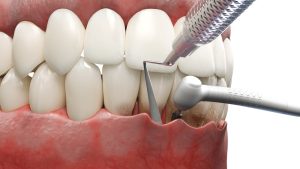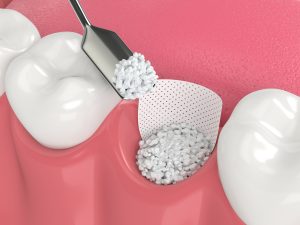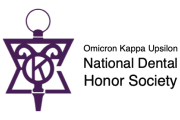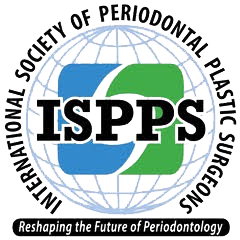A Complete Guide to Pocket Reduction Surgery With Dr. Maring
At Maring Surgical and Dental Implant Center in downtown Seattle, Dr. Susan Maring performs advanced pocket reduction surgery to treat severe periodontal disease, or gum disease. This guide details the surgical procedure, from initial consultation through recovery. We serve patients throughout Seattle and welcome those from surrounding communities, including Bellevue, Kirkland, and Mercer Island, who seek specialized periodontal care.
Pocket reduction surgery represents a time-tested treatment for managing deep periodontal infections that cannot be resolved through non-surgical methods. Dr. Maring’s extensive training in periodontics and over two decades of experience make her uniquely qualified to perform this delicate procedure with precision and care.
Ready to learn more about pocket reduction surgery? Call our Seattle periodontal specialists at 206-343-7500 to schedule your detailed consultation with Dr. Susan Maring and discover how this procedure can restore your periodontal health.
Patient Testimonials for Maring Surgical and Dental Implant Center
Our patients consistently express satisfaction with their flap surgery experience and outcomes at Maring Surgical. Here’s what some of them have shared about their treatment:
- “I have been a patient of Dr. Susan Maring’s for more than 20 years. When I have needed the help of a dentist, she knew just the right people. She demonstrates tremendous commitment to her patients. I am lucky to have her in my life.” — Susan C.
- “Everyone in the office was helpful, skillful, and efficient. I was treated with compassion and professionalism. My questions and concerns got immediate responses. I was so impressed! In addition, I experienced minimal pain after my tooth extraction.” — Marianne C.
These testimonials reflect our commitment to providing exceptional periodontal care with compassion and professionalism that our Seattle patients have come to expect from Maring Surgical.
Pre-Surgical Consultation and Planning

Digital X-rays provide essential information about bone levels and the extent of periodontal destruction. Dr. Maring analyzes these images to identify areas of bone loss and plan the surgical approach accordingly. Full-mouth radiographs may be necessary to assess the overall periodontal condition and identify any additional areas requiring treatment.
Medical history review is essential for safe surgery planning. Dr. Maring evaluates medications, allergies, previous surgeries, and systemic health conditions that might affect healing or require special precautions. Certain medications may need adjustment before surgery, and antibiotic prophylaxis might be prescribed for patients with specific medical conditions.
Treatment planning involves discussing the surgical approach, expected outcomes, and recovery timeline. Dr. Maring explains which teeth will be treated, the number of surgical sessions required, and any additional procedures that might be beneficial. Patients receive detailed written instructions for pre-operative and post-operative preparation, including dietary guidelines and medication protocols.
Local Anesthesia
Patient comfort during pocket reduction surgery is achieved through carefully selected anesthesia and sedation options. The procedure is typically performed under local anesthesia, which completely numbs the surgical area while allowing patients to remain conscious and comfortable throughout the treatment.
Local anesthesia involves injecting lidocaine or similar anesthetic agents directly into the gum tissues around the treatment area. Dr. Maring uses advanced injection techniques to minimize discomfort during anesthetic administration. The anesthesia takes effect within minutes and provides complete pain relief for several hours.
Step-by-Step Surgical Procedure

Initial incisions are made along the gum line using precise surgical instruments. These incisions create small flaps that can be lifted to expose the infected tooth roots and underlying bone structure. The incision design varies based on the specific anatomy and extent of disease in each area.
Tissue reflection involves carefully lifting the gum flaps to provide direct access to the tooth roots and infected periodontal pockets. This step requires a delicate technique to preserve healthy tissue while completely exposing the treatment area. Specialized retractors hold the tissue flaps in the proper position throughout the procedure.
Root surface preparation is a critical component of successful pocket reduction surgery. Dr. Maring thoroughly removes bacterial deposits, calculus, and infected tissue from the tooth roots using ultrasonic instruments and hand scalers. The root surfaces are then smoothed to eliminate rough areas where bacteria can re-accumulate.
Osseous surgery, improving the contour of the bone, may be necessary when irregular bone patterns contribute to deep pocket formation. Dr. Maring carefully reshapes the bone around affected teeth to create more favorable contours that can be maintained through regular oral hygiene. This step helps reduce future pocket depths and improves long-term treatment success.
Antimicrobial treatment involves applying specialized medications to eliminate remaining bacteria and promote healing. These agents may include antibiotics, antiseptics, or other therapeutic materials designed to optimize the healing environment and prevent reinfection.
Advanced Regenerative Techniques

Bone grafting materials may be placed in areas of significant bone loss to encourage new bone formation. These materials can be derived from the patient’s own bone, processed donor bone, or synthetic bone substitutes. The grafting material provides a scaffold for new bone growth while the patient’s natural healing processes take over.
Growth factors and other biological mediators may be applied to stimulate natural healing processes. These advanced materials can accelerate tissue regeneration and improve the predictability of treatment outcomes. Dr. Maring selects appropriate regenerative materials based on each patient’s specific needs and healing potential.
Tissue Repositioning and Closure
After thorough cleaning and any necessary regenerative procedures, the gum flaps are carefully repositioned to achieve optimal healing and pocket reduction. Dr. Maring adjusts the tissue position to reduce deep pockets while maintaining adequate gum coverage over the tooth roots.
Suturing techniques vary based on the surgical approach and healing goals. Primary closure involves bringing tissue edges together for optimal healing. Dr. Maring uses fine suture materials that minimize tissue trauma and promote comfortable healing.
Post-surgical dressing materials may be applied to protect the surgical site and promote comfortable healing. These materials provide a barrier against bacterial contamination while allowing normal tissue healing processes to occur. Dressings typically remain in place for one to two weeks following surgery.
Immediate Post-Operative Care

Bleeding control is typically achieved through gentle pressure using gauze pads placed over the surgical sites. You will not be bleeding when you leave the office, but some oozing may continue for 24-48 hours. Patients receive specific instructions for managing post-operative bleeding and when to contact the office.
Pain management protocols include prescribed pain medications and recommendations for over-the-counter options. Most patients experience mild to moderate discomfort that peaks two to three days after surgery and gradually subsides over the following week. Cold compresses help reduce swelling and provide additional comfort during the first 48 hours.
Swelling is normal following pocket reduction surgery and typically peaks two to three days post-operatively. Ice packs applied for 15-20 minutes at a time during the first day help minimize swelling. After 48 hours, warm compresses may be more beneficial for promoting circulation and healing.









